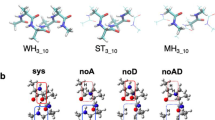Abstract
We present Monte Carlo simulations illustrating the influence of reorientation of hydrogen bonds in proteins on long-range interprotein electron transfer. The lattice protein model employed mimics the electron donor (or acceptor) interacting with an antiparallel β sheet. In addition, we take into account harmonic vibrations of the medium and also the dependence of the coupling matrix element on orientation of hydrogen bonds near the donor and/or acceptor. The results obtained show that the interaction between the tunneling electron and amino-acid residues, which are responsible for the formation of hydrogen bonds, may result in broadening the parabolic dependence of the electron-transfer rate constant on the reaction exothermicity and also in deviations from this dependence especially in the cases when the β sheet is linked with the electron donor.
Similar content being viewed by others

References
Alberts, B., Johnson, A., Lewis, J., Raff, M., Roberts, K. and Walter, P.: Molecular Biology of the Cell, Garland, New York, 2002.
Toward ab initio Theory of Long-distance Electron Tunneling in Proteins: Tunneling Currents Approach, Adv. Chem. Phys. 118 (2001), 1–44.
Pande, V.S., Grosberg, A.Y. and Tanaka, T.: Heteropolymer Freezing and Design: Towards Physical Models of Protein Folding, Rev. Mod. Phys. 72 (2000), 259–314.
Bratko, D. and Blanch, H.W.: Effect of Secondary Structure on Protein Aggregation: A Replica Exchange Simulation Study, J. Chem. Phys. 118 (2001), 5185–5194.
Miller, D.W. and Dill, K.A.: Ligand Binding to Proteins: The Binding Landscape Model, Protein Sci. 6 (1997), 2166–2179.
Castells, V., Yang, S.X. and Van Tassel, P.R.: Surface-induced Conformational Changes in Lattice Model Proteins by Monte Carlo Simulation, Phys. Rev. E 65 (2002), 031912 (8 pp.).
Zhdanov, V.P. and Kasemo, B.: Conformational Dynamics in Enzymatic Reactions, Europhys. Lett. 57 (2002), 295–301.
Zhdanov, V.P.: Non-Markovian Kinetics of Rapid Long-range Interprotein Electron Transfer, Europhys. Lett. 62 (2003), 643–649.
Zhdanov, V.P.: Folding Time of Ideal Beta Sheets vs. Chain Length, Europhys. Lett. 42 (1998), 577–581.
Khairutdinov, R.F., Zamaraev, K.I. and Zhdanov, V.P.: Electron Tunneling in Chemistry, Elsevier, Amsterdam, 1989.
Author information
Authors and Affiliations
Corresponding author
Rights and permissions
About this article
Cite this article
Zhdanov, V. Simulation of the Effect of Reorientation of Hydrogen Bonds in Proteins on Long-Range Electron Transfer. J Biol Phys 30, 365–375 (2004). https://doi.org/10.1007/s10867-004-2597-3
Issue Date:
DOI: https://doi.org/10.1007/s10867-004-2597-3



